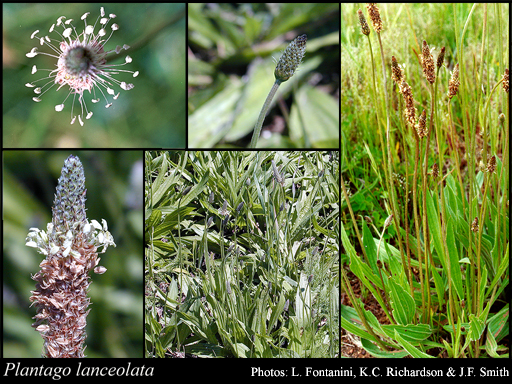- Reference
- Sp.Pl. [Linnaeus] 1:113-114 (1753)
- Conservation Code
- Not threatened
- Naturalised Status
- Alien to Western Australia
- Name Status
- Current
Rosetted perennial, herb, 0.1-0.9 m high. Fl. green-yellow-brown, Nov to Dec or Jan to Mar. Variety of soils. In gardens & other disturbed sites.

Distribution
- IBRA Regions
- Avon Wheatbelt, Geraldton Sandplains, Jarrah Forest, Nullarbor, Swan Coastal Plain, Warren.
- IBRA Subregions
- Katanning, Lesueur Sandplain, Northern Jarrah Forest, Nullarbor Plain, Perth, Southern Jarrah Forest, Warren.
- IMCRA Regions
- Leeuwin-Naturaliste, WA South Coast.
- Local Government Areas (LGAs)
- Albany, Armadale, Augusta Margaret River, Bayswater, Bridgetown-Greenbushes, Bunbury, Busselton, Capel, Cockburn, Coorow, Dardanup, Denmark, Gosnells, Harvey, Kalgoorlie-Boulder, Manjimup, Mundaring, Nannup, Narrogin, Plantagenet, Rockingham, Stirling, Swan, Wanneroo, Waroona.
Management Notes (for the Swan NRM Region)
Alternative Names. English Plantain, Narrow-Leaved Plantain, Lamb’s Tongue, Plantain.
General Biology. Growth form. Herb. Life form. Perennial. Reproduction. Primarily seed, also stem fragments. Dispersal. Soil, water, birds (including galahs and cockatoos). Seedbank persistence. Some dormancy. Fire response. Resprouts after fire.
Notes. Widely naturalised. Common weed of disturbed sites including roadsides. persistent taproot. Has longevity of 1-3 years. Likely wind pollinated. Main growth period is in spring and autumn, grows moderately in winter, and opportunitistically in summer. A deep persistent taproot gives it some drought tolerance. Germinates in darkness and with earlier germination, larger seedling size and longer leaves, it is more competitive than other than Plantago species. Has evolved resistance to Group G/9 herbicides in South Africa.
Additional information. Origin. Europe, temperate and tropical Asia, North Africa. History of use/introduction. Animal forage. Similar native species. Plantago debilis, P. drummondii, P. exilis.
Suggested method of management and control. Hand remove small/isolated infestations. Spray in early stages of growth with 1% glyphosate. Read the manufacturers' labels and material safety data sheets before using herbicides. For further information consult the Australian Pesticides and Veterinary Medicines Authority to determine the status of permits for your situation or state.
Management Calendar
| Calendar Type | Jan | Feb | Mar | Apr | May | Jun | Jul | Aug | Sep | Oct | Nov | Dec | Comments |
|---|---|---|---|---|---|---|---|---|---|---|---|---|---|
| Germination | U | U | U | ||||||||||
| Active Growth | O | O | O | Y | Y | Y | Y | Y | Y | Y | Y | O | |
| Flowering | Y | Y | Y | Y | Y | ||||||||
| Fruiting | Y | Y | Y | Y | |||||||||
| Manual Removal | Y | Y | Y | Y | Y | Y | Y | Y | Y | Y | Y | Y | |
| Herbicide Treatment | Y | Y | Y | Y | Y | Y |
Legend: Y = Yes, regularly, O = Occasionally, U = Uncertain, referred by others but not confirmed.
References
- Botanic Gardens Trust NSW () Plantago lanceolata. Department of Environment, Climate Change and Water, Sydney. URL: http://www.rbgsyd.nsw.gov.au/science/Evolutionary_Ecology_Research/Ecology_of_Cumberland_Plain_Woodland/woodland_plants/plantago_lanceolata - Accessed September 2010.
- Brown, K. & Brooks, K. (2002) Bushland Weeds: A Practical Guide to their Management. Environmental Weeds Action Network, Greenwood.
- Heap, I. (2010) The International Survey of Herbicide Resistant Weeds. Online: Group G/9 Resistant Buckhorn Plantain (Plantago lanceolata). WeedScience.org URL: http://www.weedscience.com - Accessed September 2010.
- Hussey, B.M.J., Keighery, G.J., Dodd, J., Lloyd, S.G. & Cousens, R.D. (2007) Western Weeds. A guide to the weeds of Western Australia. 2nd Edition. The Plant Protection Society of Western Australia, Victoria Park.
- Moore, C.B. & Moore, J.H. (2002) Herbiguide, the pesticide expert on a disk. Herbiguide, PO Box 44 Albany, Western Australia, 6330.
- Moore, G., Sanford, P. & Wiley, T. (2006) Perennial pastures for Western Australia, Bulletin 4690. Department of Agriculture and Food, Perth.
- Pons, T.J. & Toorn, J. (1988) Establishment of Plantago lanceolata L. and Plantago major L. among grass. Oecologia, 75 (3): 394-399.
- Sagar, G.R. & Harper, J.L. (1961) Controlled interference with natural populations of Plantago lanceolata, P. major and P. media. Weed Research, 1 (3): 163–176.
- Swarbrick, J.T. & Skarratt, D.B. (1994) The bushweed 2 database of environmental weeds in Australia. The University of Queensland, Gatton College.
- USDA, ARS, National Genetic Resources Program (2009) Germplasm Resources Information Network - (GRIN). National Germplasm Resources Laboratory, Beltsville, Maryland. URL: https://npgsweb.ars-grin.gov/gringlobal/taxon/taxonomysimple.aspx - Accessed October 2009.